Introduction: Dangers of Plastic Use
- Plastic products pollute waterways: 13,000 pieces of plastic waste found on every 1m2;
- Plastic infiltrates food: toxins found in plastic (BPA, phthalates) can transfer to food;
- Plastic causes danger to wildlife: 700 marine species suffer from the polluted by plastic waters;
- Plastic waste pollutes the landfill due to inefficient recycling (West, 2017).
Despite the fact that plastic is a popular material used for manufacturing an array of products, its disposal has yet been inefficient, which led to the exponential pollution of land and waterways. Importantly, plastic waste causes danger to wildlife that gets caught in polyethylene bags or chokes on small plastic parts such as bottle caps. Moreover, food that people consume every day also gets polluted with toxins that can be found in plastic packaging or containers.
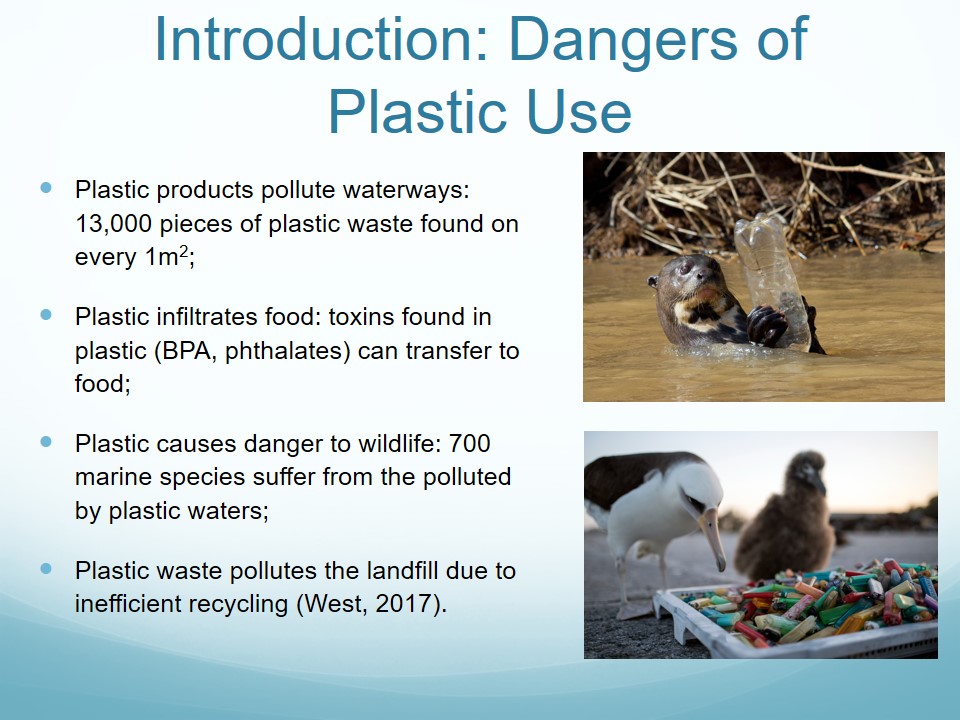
Plastic Use Facts
- A million of plastic bottles are bought globally every minute (Laville & Taylor, 2017);
- 50% of all plastic is only used ones and thrown away;
- Plastic accounts for 10% of total global waste;
- 500 billion plastic bags are used worldwide.
Our environment has experienced and continues experiencing an array of sustainability challenges, and human activity has the most adverse influence on the decrease of the environment’s quality. It this presentation, it has been proposed to reduce the use of plastic products despite their wide popularity. As evidenced by plastic use facts presented in the slide, plastic is currently used and disposed of inefficiently. Because plastic accounts for a large portion of global waste, implementation of an initiative that will raise awareness of the problem is needed.
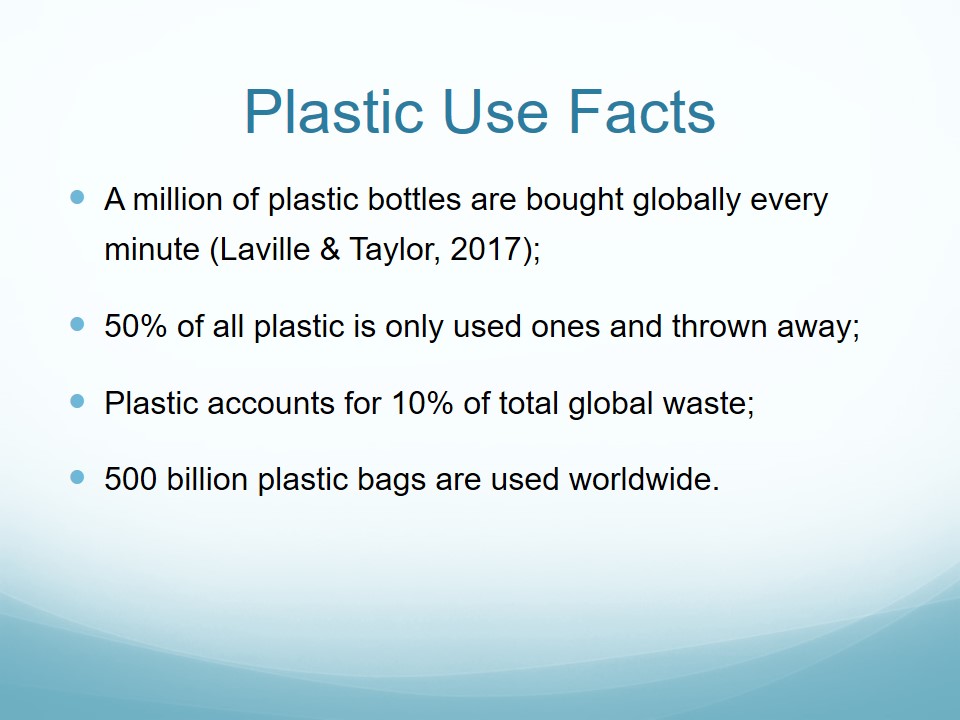
Alternatives to Plastic
- Glass bottles can replace those made from plastic and reused multiple times;
- Reusable shopping bags substitute plastic bags;
- Plastic straws replaced by metal straws;
- Reusable water bottles and coffee mugs substitute the one-use plastic cups.
While plastic products are considered essential in everyday life, it is important to know alternatives that do not have a harmful effect on the environment. Apart from buying in bulk and using bags made from canvas, consumers can make such easy substitutions as replacing plastic one-use water bottles for reusable ones or choosing glass bottles that can be recycled easily and efficiently. However, throwing plastic away and buying substitutes is also inefficient; if a plastic bottle or container can be reused, it is advised not to throw it away.
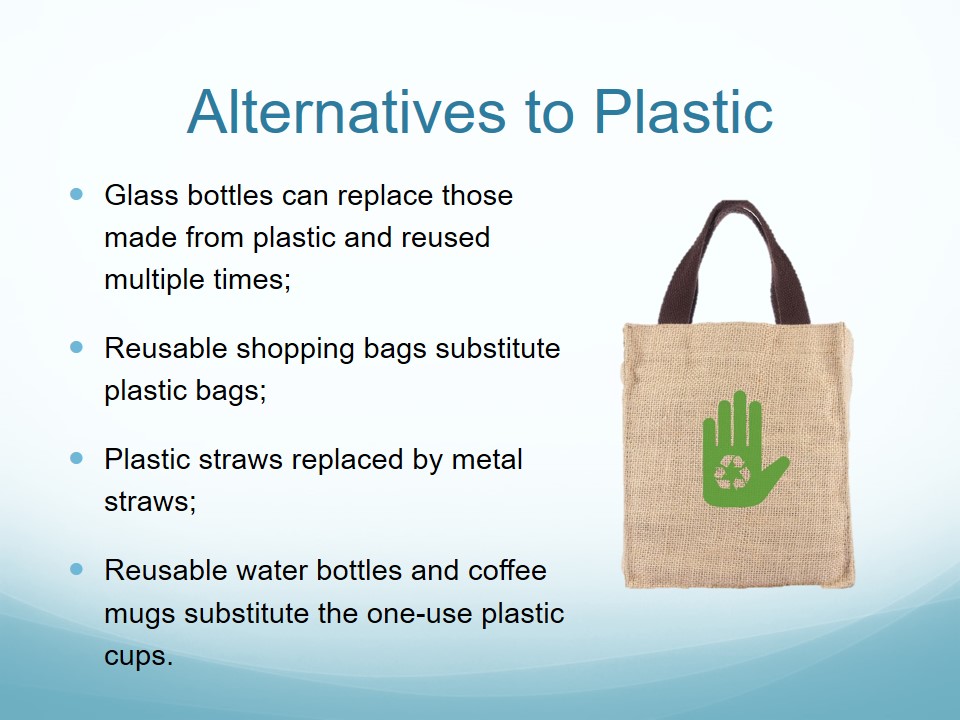
Benefits of Using Less Plastic
- Reduction of landfill and non-biodegradable waste;
- Elimination of waste that pollutes oceans and harms animals;
- Improvement of health-related outcomes due to the toxicity of plastic;
- Reduction of atmospheric pollution associated with the production of plastic.
As expected, benefits of using less plastic are directly associated with the improvement of the environment and the introduction of sustainable practices that will subsequently enhance the quality of life on Earth for both humans and animals. The use of less plastic will reduce the amounts of waste that pollute landfills and oceans, thus avoiding the harm caused to animals. As mentioned previously, plastic toxins (e.g., BPA) can transfer on food and lead to health issues, which means that the reduction of plastic use may improve the overall community health.
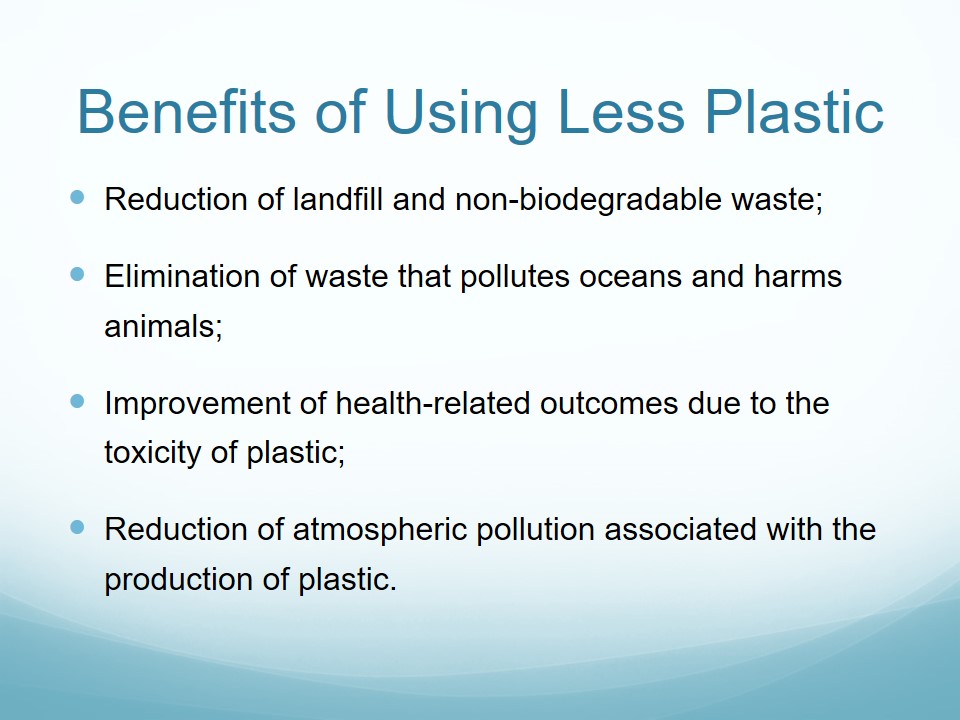
“Less plastic” Initiative: Reduce Plastic Use
Brief overview of the environmental initiative:
- Reduce plastic use in local schools, universities, and businesses;
- Provide education for the community on the benefits of plastic use;
- Implement community activities such as meetings and cleanups of local areas.
It is proposed to implement a “Less Plastic” initiative that will cover three action areas. The first area relates to the reduction of plastic use in local schools, businesses, and universities since they have the most people located in one place. The second area is community education to raise awareness of the problem of pollution with plastic. The third area is community meetings, workshops, and gatherings for sharing experiences and best practices as well as cleaning up surrounding areas from plastic garbage that is not biodegradable and thus takes years to disintegrate.

Initiative: I. Reduction of Plastic Use by Businesses and Educational Facilities
- Encourage facilities to buy products in bulk and thus use less plastic packaging;
- Offer workers/students an option of bringing reusable containers or plates from home;
- Find community activists who could promote the “less plastic” message to schools and businesses;
- Contact state representatives and ask for support in the reduction of plastic use.
As the first point of the initiative, it is proposed for businesses and educational facilities to take action in reducing the amount of plastic they use for everyday activities. This can be achieved through introducing alternatives to plastic, finding activists who will monitor this process, contacting relevant stakeholders and encouraging their participation. Importantly, it is essential to educate businesses and schools on the importance of bulk buying and the use of canvas or other reusable materials for storing produce.
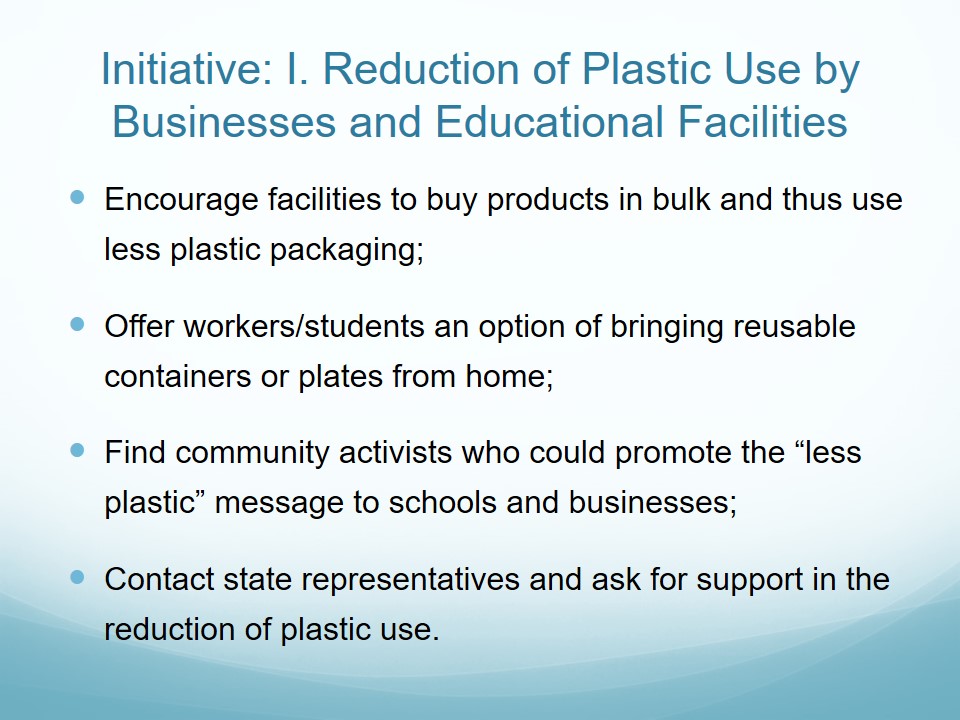
Initiative: II. Educating the Community
- Educate on the cost-effectiveness of “less plastic”;
- Make and distribute educational material (pamphlets, newsletters, etc.) that inform the public on the benefits of “less plastic”;
- Introduce educational workshops that teach about practices of reducing plastic use;
- Collaborate with grocery stores and malls to encourage the public to purchase reusable shopping bags.
Community education and awareness in the second step of the “less plastic” initiative. It implies an array of practices associated with the distribution and creation of educational materials for the community. Also, this educational step can be extended to meetings and workshops where participants could share their best practices on the reduction of plastic waste. Lastly, businesses can also participate through encouraging the purchasing of reusable bags made from canvas, cardboard, and others.
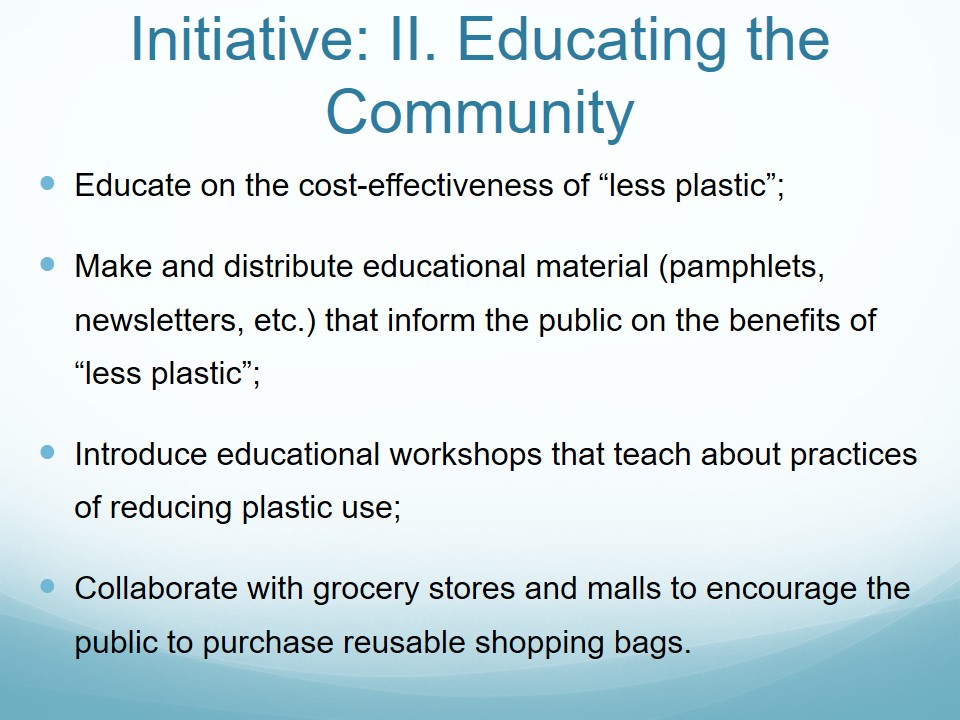
Initiative: III. Community Activities and Gatherings
- Introduce weekly gatherings to collect plastic waste from parks, playgrounds, schoolyards;
- Carry out seminars and meetings for people to share their experiences with “less plastic”;
- Involve community stakeholders such as businesspeople and politicians;
- Identify challenges associated with involving the whole community.
As to the last point of the initiative, it is directly linked to community participation in the discussion and actions to reduce plastic use and disposal. Such practices can include seminars, the involvement of stakeholders such as celebrities and politicians who can influence the public opinion. Another point for consideration within this step is the identification of possible challenges that communities face when it comes to being sustainable. Cleaning up garbage is also important for the initiative because it will teach the community that it takes hard work to eliminate plastic waste.
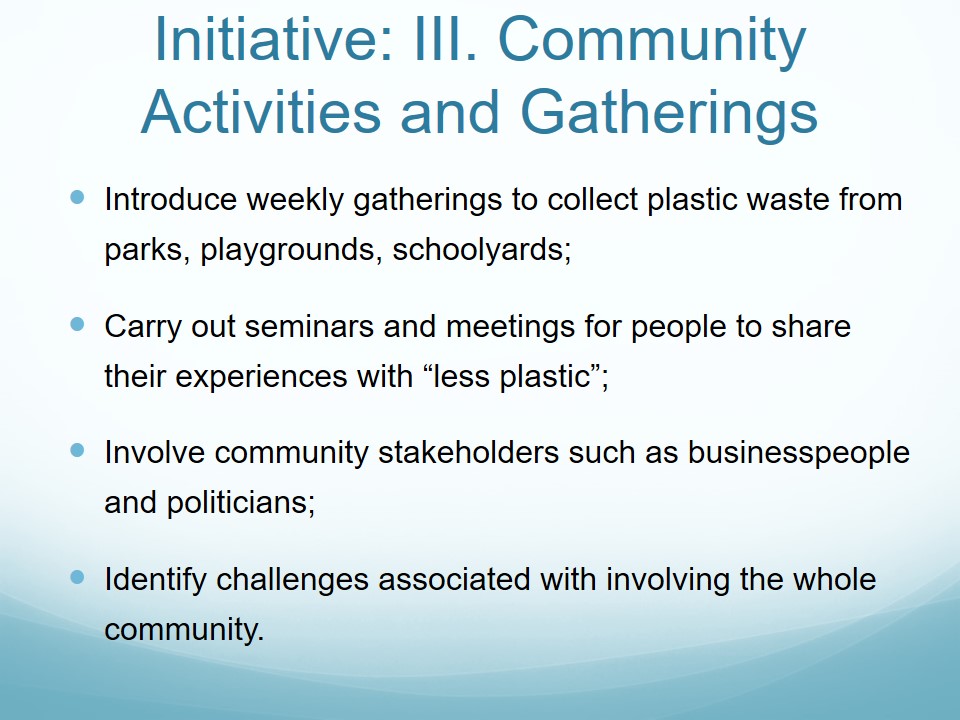
Stakeholders for the Initiative
- Owners, employees, and customers of businesses (Madsen & Ulhoi, 2015);
- Students, teachers, and personnel;
- Community activists, politicians, policymakers;
- Local celebrities that can influence community opinions.
Because the initiative involves the direct participation of people, it is important to identify stakeholders who can play a positive role in the elimination of plastic waste and promotion of sustainable practices for the improvement of the quality of life. As to the first point of the initiative, owners, customers, and employees of businesses are expected to participate the most along with students, teachers, and school personnel. In the community education step, activists, policymakers, and politicians are expected to make a change with the support from relevant influencers (TV personalities, musicians, artists) whose opinions matter to people who live in the community.
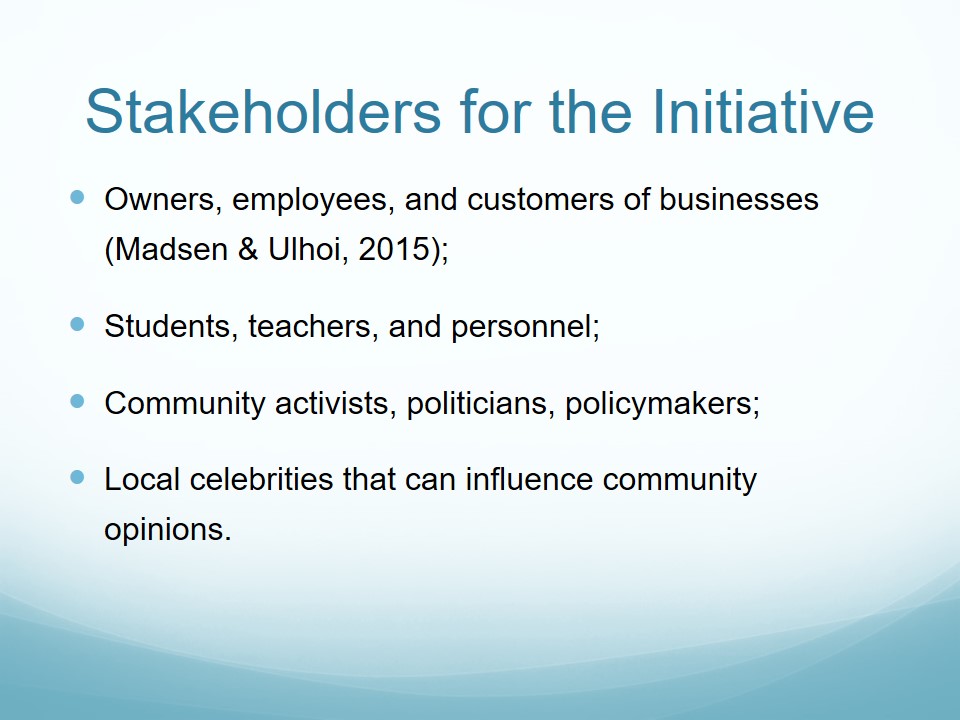
Opportunities of the Initiative
- Reduction of plastic use within the community;
- Introduction of sustainable practices associated with conscious consumption;
- Raising awareness of the problem and positively influencing its management;
- Presenting an example for other communities worldwide to eliminate the use of harmful plastic.
It is expected that the implementation of the initiative will lead to an array of positive opportunities that communities may use to their advantage in the future. If the initiative is successfully introduced, it will teach the community on how to remain sustainable and make conscious choices in favor of the environment. The initiative can also become an example for other communities globally on how to reduce their plastic use and waste and subsequently mitigate the adverse problems that human activities have imposed on the environment.

Challenges of the Initiative
- Lack of public attention to environmental hazards caused by plastic use;
- Consumer habit to purchase plastic bottles, bags, containers;
- Wide availability of plastic products that are cheaper (short-term) than alternatives;
- Lack of government support in reducing environmental challenges.
It is expected to encounter some challenges during the implementation of the initiative. Despite the wide popularity of the plastic use problem in media, the public rarely pays attention because it considers it unimportant. Since consumers are used to purchasing plastic products, it is complicated to convince them not to. Also, plastic is considered cheaper despite the fact that it is most cost-efficient to buy a more expensive metal water flask and refill it when needed than buying water in one-use bottles every day.

Conclusion
- Plastic use is a pervasive issue that negatively affects the environment;
- Unified efforts are needed to reduce its use;
- “Less plastic” is an initiative that could change public thinking and promote sustainable practices;
- Community education, gatherings, and practices to reduce plastic use in businesses and schools can reduce the problem.
In conclusion, it is essential to mention that the problem of plastic use is growing each day and efforts to manage it have yet been ineffective. Because of this, it was proposed to implement the “Less plastic” initiative consisting of three aspects for promoting sustainable practices and educating the community on the importance of conscious consumption and the use of man-made products made from recyclable, reusable, or biodegradable materials.
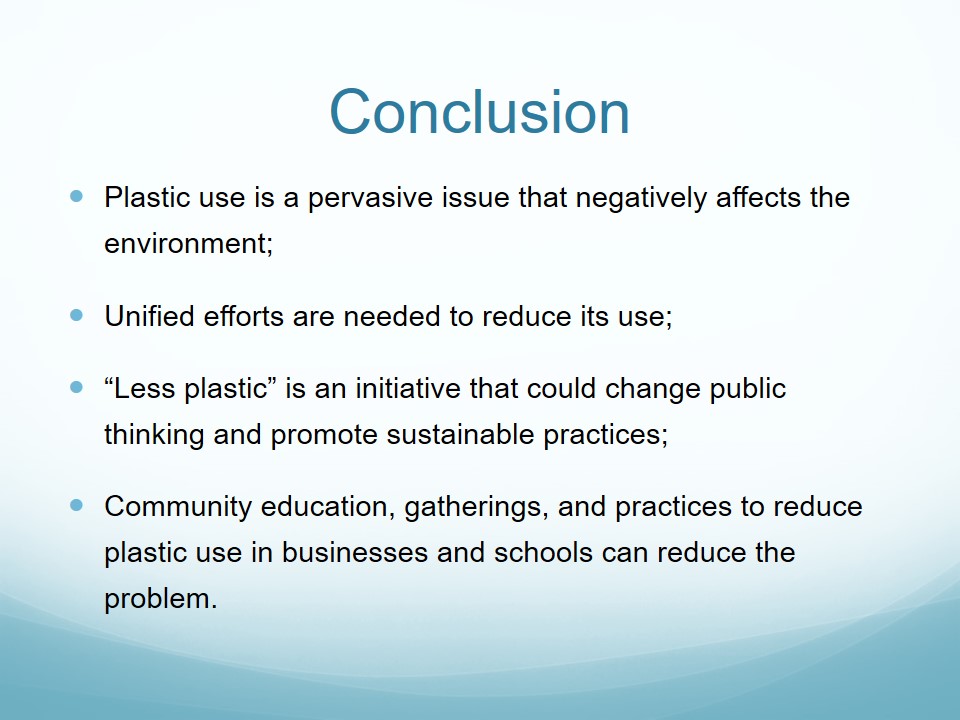
References
Laville, S., & Taylor, M. (2017). A million bottles a minute: World’s plastic binge ‘as dangerous as climate change.’ Web.
Madsen, H., & Ulhoi, J. (2015). Stakeholder pressures, environmental impact and managerial initiatives of SMEs: A longitudinal study. The Journal of the Transdisciplinary Environmental Studies, 14(1), 13-26.
West, L. (2017). Why you should stop using plastic bags. Web.